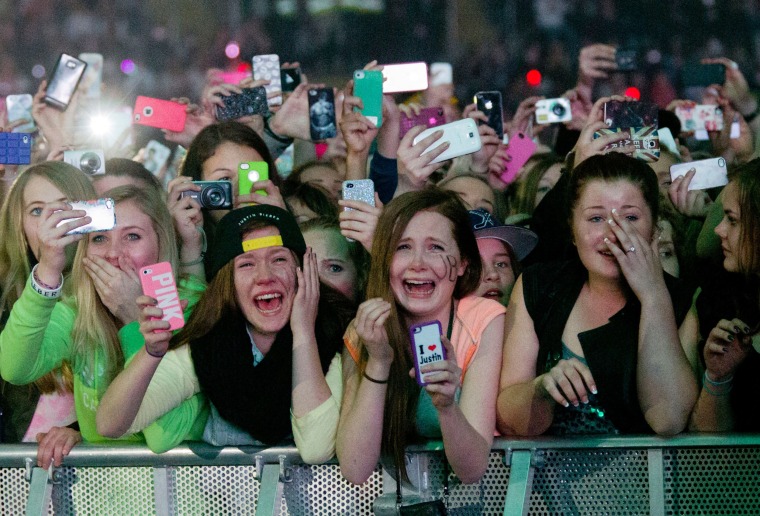What do people dressed up in Harry Potter costumes waiting for a book release have in common with the pilgrims to the annual Berkshire Hathaway meeting?
They’re all devoted superfans, and they’re the subject of the new book “Superfandom: How Our Obsessions Are Changing What We Buy and Who We Are.”
“Fandom is a topic that has a lot of baggage. We associate it with crying tweens at a Bieber concert, or elderly eccentrics collecting beanie babies,” says Zoe Fraade-Blanar, who wrote the book with Aaron Glazer.

These devoted fans — the renaissance fair attenders, Star Trek groupies and Beliebers of the world — have always intrigued and bewildered me, because I can’t relate. I don’t root for any sports team. I don’t wait for anyone’s surprise singles to drop. I like some authors and some movies and some TV shows, but the closest I’ve come to obsession is reading up on alternate “Mad Men” theories.
But in Fraade-Blanar and Glazer’s telling, over the last 20 years superfandom has exploded to include almost everyone. They encountered devoted fans first-hand at their plush toy company, Squishables, which relied on crowdsourcing for new products, to the delight and sometime dismay of their vocal fanbase.
“The internet has removed a lot of the stigma to being a fan — for the first time it’s safe for us to pursue the things we love and no one has to know,” Fraade-Blanar says.
So Fraade-Blanar (a fan of Golden Age murder mysteries) and Glazer (“a superfan of the Starwood Preferred Guest program”) set out to demystify the phenomenon. “We thought it was time to own it,” Fraade-Blanar says. They explained their own fan-obsession to NBC News BETTER.

Zoe Fraade-Blanar: For one thing, fandom is fun! Academics and marketers alike often miss out on the salient reason people become fans of things — it’s a good time. It’s something to do, most often in a group, and having fun in a group feels good. Of course, there are very real psychological benefits too — hardcore fans, at least those who are given a chance to interact with others like themselves, have lower rates of anxiety and depression than the general population. Fandom teaches coping techniques for dealing with disappointment, and how to celebrate victories in a safe way. And it usually comes with a community that can act as a safety net when things get bad. Fandom is fun, but it’s also great for you.
Is there something that makes these devoted fans different from other people? What drives them?
Aaron Glazer: The superfans we talk about in Superfandom aren’t different than other people — or even other fans. In fact, deep down, almost everyone is a fan of something, even if they prefer to use phrases like “aficionado” or “connoisseur." What differentiates superfans is that they are emotionally invested in the fandom and, often, much of their personal identity is intertwined with their fandom. That level of buy-in often leads them to spend a tremendous amount of their personal time and energy in support of the fan object, helping it become better and developing what it stands for.

Glazer: Fandom has historically been viewed as a consumptive activity. Fans watch Yankees games, they read Harry Potter books, and they listen to Beatles albums. If they’re a hardcore fan, they might watch or read or listen to them a lot. But that’s not really how fandom works. Fandom is more than just loving something more than normal, and it rarely exists in isolation. For superfans, fandom is performative, active, and social. WWE superfans don’t just attend wrestling events; they spend hours researching the story lines and speculating with each other on the internet about what the next major event will bring. They might even start their own backyard wrestling events to try it themselves. Fandom is a set of activities —pilgrimages, creating rituals and traditions, wearing special clothes or symbols, socializing, evangelizing to create new fans — that people can do in the service of the things they love.
“Superfandom” starts with a story about a girl’s obsession with Liszt and Mozart, so it’s not a new phenomenon. But how has it changed over time?
Fraade-Blanar: Fandom is ancient — as long as there’s been culture there’s been fandom. What’s changed over the years is the level of access. Our Liszt-obsessed Victorian would have access to music whenever a touring orchestra was in town or reachable by train. Fifty years later, she might simply pull Liszt up on a phonograph. Today it takes only the click of a button. Now that the internet has reduced the energy required for acquisition to practically nothing, it takes a lot more to prove that we really care about the things we love. Anyone can listen to Liszt, but only true fans take the draw pictures of him as an anime character. And we have a lot more energy left over to do it too, now that we don’t have to spend all that time riding trains between distant concert halls.
Part of your book looks at fandom gone wrong. What are some of the biggest missteps companies can make?
Fraade-Blanar: Being part of a group of people who care deeply about something is fun and romantic and empowering. But being part of an angry mob feels fun and empowering too, and it’s exciting besides. Fandom is inherently conservative — it’s literally an institution set up to preserve something. Fans have internalized the meaning of a fan object and made it part of their lives, and any updates to that meaning is deeply personal. When a fan object makes changes, even when they’re business decisions that are required for its continued existence, it’s easy for fans to rebel. Many a fan would rather see the thing they claim to love metaphorically “dead rather than dishonored.”
Companies can become so terrified of fan rebellions that they let their fan group, a group which may not actually represent their general audience, sway their decisions in a way that’s not in their best interests. The tyranny of the vocal minority is a very real thing, and it’s easy to forget that those opinions, deafening and vitriolic though they may be, often represent the perspectives of a only a very small group of people.
What would you say to someone — a business, an aspiring social media star — who wants to find superfans?
Glazer: In the book, we posit a Superfandom equation: for fandom to form, you need a critical mass, a platform, and emotional response. What that looks like in reality is often more complex. The critical mass required to support a fandom varies greatly based on the fan object — for a professional sports team, you may need thousands of fans; for an online webcomic, you might just need dozens — but in all cases you need a place for fans to congregate and you need a fan object to which that people can feel emotionally connected.
Anyone hoping to attract superfans needs to set up the conditions to let it happen and, in the parlance, love bomb the firestarters — meaning, once you have early fans on board, provide them with the support and appreciation they need and deserve, and then get out of the way and let them build a community.

